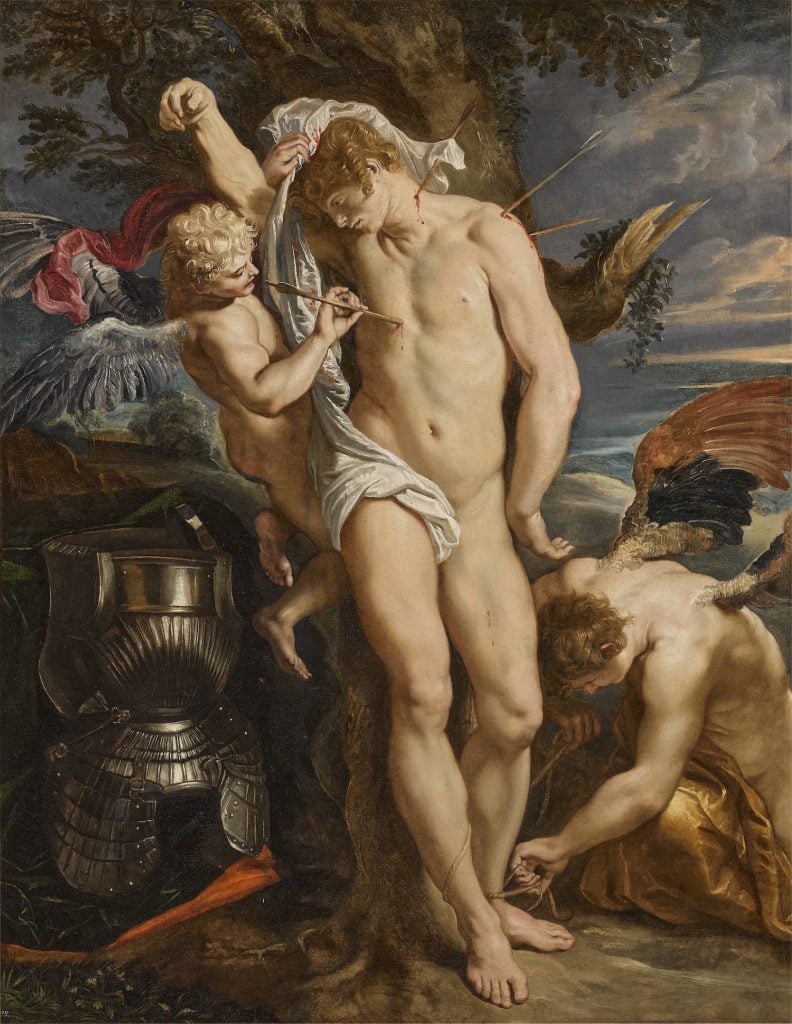Auctions
Rubens Painting Lost For 300 Years and Misidentified When Last Sold at Auction Will Star At Upcoming Sotheby’s Sale in London
Research and x-ray analysis revealed that the painting is far more important than previously thought.

Research and x-ray analysis revealed that the painting is far more important than previously thought.

Eileen Kinsella

A painting that lost its identity over the course of 300 years has now been re-affirmed as an important Old Master work and will be offered at a Sotheby’s sale in London in early July.
The painting in question is Sir Peter Paul Rubens’ Saint Sebastian Tended By Two Angels. It has an estimate of £4 million to £6 million ($5 million to $7.7 million).
The tale of the Rubens is a “classic” art mystery about a painting which, between leaving a prestigious Italian collection in the 1730s and then reappearing in Missouri in the 20th century, had lost all provenance for centuries. That mystery has now been solved.
Scholars and experts on the Sotheby’s team used X-rays to look beneath the surface of the painting, and recently confirmed that it is indeed a work by Rubens. Further, they discovered that it’s “the prime” version of another important work by the artist, which until very recently had been thought to be unique.
The painting had been last recorded in the collection of the artist’s Genovese patrons, the Spinola family, in the early 1730s. When the work resurfaced at auction 15 years ago, it was with an attribution to the French painter Laurent de la Hyre. At the time, it sold at Ivey-Selkirk, a St. Louis auction house, for $40,000, according to the Artnet Price Database. Though modest in comparison to the current estimate, that sum was still many multiples of the high $8,000 estimate.
Soon after that auction, it was identified as a Rubens composition, and scholars embarked on extensive research that ended up matching the canvas to a Rubens referenced in the wills and inventories of the Spinola family.
The painting was likely executed circa 1606-8 in Italy, or circa 1609-10 in Antwerp, although there is not complete scholarly consensus. Rubens’ close association with the Spinola family began when he was first in Genoa in 1604, and long outlasted his return to Antwerp in late 1608.
It’s likely that the painting was commissioned by Ambrogio Spinola (1594-1630), an Italian nobleman and military commander, with whom the artist enjoyed shared diplomatic, political and artistic interests, and who he painted several times. The first known record of the painting is in the will of Ambrogio’s son, Filippo Spinola in 1655, before it passed through successive generations of the family for eighty years. The trail went cold with the patron’s granddaughter Anna Spinola who was listed in 1731 as having inherited the painting.
Saint Sebastian Tended By Two Angels then passed out of the Spinola family and through the female line of descent via Anna Spinola, and became untraceable until its reappearance in the U.S. 230 years later, in a collection in Missouri in 1963. It was later acquired by the present owner in the aforementioned auction in 2008 as a painting by Laurent de la Hyre.
The highest-ever price achieved for a de la Hyre work at auction is €918,400 ($922,000) for Narcisse, sold at Artcurial Paris last fall. Meanwhile the record for a Rubens work at auction is £49.5 million ($76.5 million) for Massacre of the Innocents (1609-11), sold at Sotheby’s London in 2002.
The X-ray analysis also revealed additional secrets about the status of the painting as the prime version for another Rubens painting of the same subject that was held for centuries by the Italian Corsini family and now hangs at Galleria Corsini in Rome.
The artist made radical changes to the design as he painted the Spinola version, altering and tweaking the composition as he worked. For example, Saint Sebastian was first painted facing the opposite way, twisting to the left and with his right arm raised over his head. There was originally an arrow piercing his right thigh, and armor was a later addition to the work, painted on top of something else that Rubens scraped away. Meanwhile, x-ray analysis of the Corsini picture showed no significant changes at all, suggesting that it was executed afterwards, and once Rubens was satisfied with his design, according to Sotheby’s.
The discovery is “proof that even great artists’ names can be lost to history,” said George Gordon, Sotheby’s co-chairman of Old Master paintings worldwide. “Thankfully the fascinating detail revealed by scientific analysis, combined with meticulous research, and consideration by leading scholars, rightfully affirms the reattribution of this work to one of the greatest painters of his time, and shows us that there is still so much for us to discover, even about the artist’s best-known works.”
More Trending Stories:
Is Time Travel Real? Here Are 6 Tantalizing Pieces of Evidence From Art History